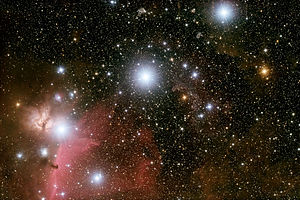HD 36780
Appearance
| Observation data Epoch J2000 Equinox J2000 | |
|---|---|
| Constellation | Orion |
| Right ascension | 05h 34m 04.04767s[1] |
| Declination | −01° 28′ 12.9115″[1] |
| Apparent magnitude (V) | +5.895[2] |
| Characteristics | |
| Spectral type | K4III[3] |
| U−B color index | +1.87[4] |
| B−V color index | +1.55[4] |
| Astrometry | |
| Radial velocity (Rv) | 88.40 ± 1.7[5] km/s |
| Proper motion (μ) | RA: −13.59[1] mas/yr Dec.: −19.95[1] mas/yr |
| Parallax (π) | 4.77 ± 0.54 mas[1] |
| Distance | approx. 680 ly (approx. 210 pc) |
| Other designations | |
| Database references | |
| SIMBAD | data |
HD 36780 is an orange giant star with a visual magnitude of 5.92, barely visible by the naked eye. It is located in Orion's belt, 843 light years distant from Earth.
References
- ^ a b c d e van Leeuwen, F.; et al. (2007). "Validation of the new Hipparcos reduction". Astronomy and Astrophysics. 474 (2): 653–664. arXiv:0708.1752. Bibcode:2007A&A...474..653V. doi:10.1051/0004-6361:20078357.
- ^ Høg, E.; et al. (2000). "The Tycho-2 catalogue of the 2.5 million brightest stars". Astronomy and Astrophysics. 355: L27–L30. Bibcode:2000A&A...355L..27H.
- ^ Houk, N.; Swift, C. (1999). "Michigan catalogue of two-dimensional spectral types for the HD Stars, Vol. 5". Michigan Spectral Survey. 5: 0. Bibcode:1999MSS...C05....0H.
- ^ a b Johnson, H. L. (1966). "UBVRIJKL Photometry of the Bright Stars". Communications of the Lunar and Planetary Laboratory. 4: 99. Bibcode:1966CoLPL...4...99J.
- ^ Gontcharov, G. A. (2006). "Pulkovo Compilation of Radial Velocities for 35 495 Hipparcos stars in a common system". Astronomy Letters. 32 (11): 759–771. arXiv:1606.08053. Bibcode:2006AstL...32..759G. doi:10.1134/S1063773706110065.
- ^ "HD 36780". SIMBAD. Centre de données astronomiques de Strasbourg. Retrieved 13 March 2017.

